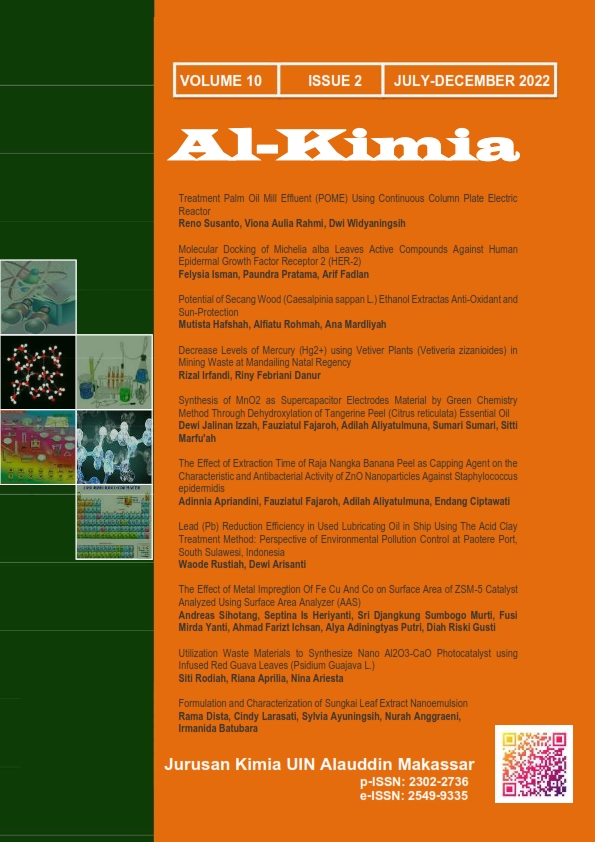The Effect of Extraction Time of Raja Nangka Banana Peel as Capping Agent on the Characteristic and Antibacterial Activity of ZnO Nanoparticles Against Staphylococcus epidermidis
Abstract
A green chemistry-based ZnO nanoparticle synthesis method based on plant extracts has been developed. Raja nangka banana peel is one of them. The extraction time is one of the elements that influences the amounts of secondary metabolites. The longer the extraction time, the more secondary metabolites are obtained. If the optimal time is exceeded, the secondary metabolite compounds will decrease. The purpose of this research was to determine the optimal time to extract secondary metabolites from the raja nangka banana peel and to know the effect of extraction time on the characteristics of ZnO nanoparticles, which include morphology, size, and antibacterial activity against Staphylococcus epidermidis. The steps of this research: maceration, phytochemical tests and total levels tests, synthesis of ZnO nanoparticles, characterization, and antibacterial activity test against Staphylococcus epidermidis. Maceration for 24 hours is the best time for extracting secondary metabolites from raja nangka banana peels. The SEM test results show that the morphology of the three samples had agglomeration. The ZnO nanoparticles with 24-hour raja nangka banana peel extract had a smaller size of 295.2 nm and were spherical. Inhibition zone diameter from ZnO nanoparticles with 24-hour raja nangka banana peel extract has a larger area of 5.65 mm.
Downloads
References
Chintya, N., & Utami, B. (2017). Ekstraksi Tannin dari Daun Sirsak (Annona muricata L.) sebagai Pewarna Alami Tekstil. JC-T (Journal Cis-Trans): Jurnal Kimia Dan Terapannya, 1(1), 22–29.
Danaei, M., Dehghankhold, M., Ataei, S., Hasanzadeh Davarani, F., Javanmard, R., Dokhani, A., Khorasani, S., & Mozafari, M. R. (2018). Impact of Particle Size and Polydispersity Index on the Clinical Applications of Lipidic Nanocarrier Systems. Pharmaceutics, 10(2), 1–17.
Febrina, L., Rusli, R., & Muflihah, F. (2015). Optimalisasi Ekstraksi dan Uji Metabolit Sekunder Tumbuhan Libo (Ficus variegate Blume). Journal of Tropical Pharmacy and Chemistry, 3(2), 74–81.
Hoseinzadeh, E., Makhdoumi, P., Taha, P., Hossini, H., Stelling, J., Kamal, M. A., & Ashraf, G. M. (2017). A Review on Nano-Antimicrobials: Metal Nanoparticles, Methods, and Mechanisms. Current Drug Metabolism, 18(000–000), 1–9.
Mukhoyyaroh, N. I., & Hakim, L. (2020). Etnobotani Pemanfaatan Pisang Lokal (Musa spp.) di Desa Srigonco, Kecamatan Bantur, Kabupaten Malang. BIOTROPIKA: Journal of Tropical Biology, 8(1), 43–53.
Mukhriani, Sugiarna, R., Farhan, N., Rusdi, M., & Arsul, M. I. (2019). Kadar Fenolik dan Flavonoid Total Ekstrak Etanol Daun Anggur (Vitis vinifera L.). Ad-Dawaa’ Journal of Pharmaceutical Sciences, 2(2), 95–102.
Nitasari, D. W. (2020). Sintesis Nanopartikel Seng Oksida (NP ZnO) Menggunakan Ekstrak Kulit Pisang Tanduk (Musa paradisiaca) sebagai Capping Agent serta Karakterisasi dan Uji Aktivitasnya sebagai Antibakteri, Skripsi, Malang. Universitas Negeri Malang.
Nuratikhoh, A. (2019). Sintesis Nanopartikel Seng Oksida (ZnO) Menggunakan Ekstrak Kulit Pisang serta Uji Aktivitas Antibakteri, Skripsi, Malang. Universitas Negeri Malang.
Nurlina, Y., & Syahbanu, I. (2020). Sintesis Nanopartikel Zink Oksida (ZnO) dengan Penambahan Ekstrak Klorofil dari Daun Suji sebagai Sumber Capping Agent. POSITRON, 10(2), 123–130.
Romadhan, M. F., & Pujilestari, S. (2018). Sintesis Nanopartikel ZnO dan Aplikasinya sebagai Edible Coating Berbasis Pektin untuk Memperpanjang Umur Simpan Buah Belimbing. Jurnal Agroindustri Halal, 5(1), 30–38.
Sabdoningrum, E. K., Hidanah, S., Chusniati, S., & Soeharsono. (2021). Characterization and Phytochemical Screening of Meniran (Phyllanthus niruri Linn) Extract’s Nanoparticles Used Ball Mill Method. Pharmacognosy Journal, 13(6), 1568–1572.
Taurina, W., Sari, R., Hafinur, U. C., Wahdaningsih, S., & Isnindar. (2017). Optimasi Kecepatan dan Lama Pengadukan terhadap Ukuran Nanopartikel Kitosan-Ekstrak Etanol 70% Kulit Jeruk Siam (Citrus nobilis L.var Microcarpa). Traditional Medicine Journal, 22(1), 16–20.
Vanathi, P., Rajiv, P., Narendhran, S., Rajeshwari, S., Rahman, P. K. S. M., & Venckatesh, R. (2014). Biosynthesis and Characterization of Phyto Mediated Zinc Oxide Nanoparticles: A Green Chemistry Approach. Materials Letters, 134, 13–15.
Vishnupriya, B., Nandhini, G. R. E., & Anbarasi, G. (2020). Biosynthesis of Zinc Oxide Nanoparticles Using Hylocereus undatus Fruit Peel Extract Against Clinical Pathogens. Materials Today: Proceedings, 1–5.
Wahab, R., Kim, Y. S., & Shin, H. S. (2011). Fabrication, Characterization and Growth Mechanism of Heterostructured Zinc Oxide Nanostructures via Solution Method. Current Applied Physics, 11(3), 334–340.
Wahyuni, D. T., & Widjanarko, S. B. (2015). Pengaruh Jenis Pelarut dan Lama Ekstraksi terhadap Ekstrak Karotenoid Labu Kuning dengan Metode Gelombang Ultrasonik. Jurnal Pangan Dan Agroindustri, 3(2), 390–401.
Widodo, S., Yusa, N. M., & Timur Ina, P. (2021). Pengaruh Waktu Maserasi Terhadap Aktivitas Antioksidan Ekstrak Daun Mundu (Garcinia dulcis (Roxb.) Kurz). Jurnal Ilmu Dan Teknologi Pangan (ITEPA), 10(1), 14.
Authors who publish with this journal agree to the following terms:
1) Authors retain copyright and grant the journal right of first publication with the work simultaneously licensed under a Creative Commons Attribution License that allows others to share the work with an acknowledgement of the work's authorship and initial publication in this journal.
2) Authors are able to enter into separate, additional contractual arrangements for the non-exclusive distribution of the journal's published version of the work (e.g., post it to an institutional repository or publish it in a book), with an acknowledgement of its initial publication in this journal.
3)Authors are permitted and encouraged to post their work online (e.g., in institutional repositories or on their website) prior to and during the submission process, as it can lead to productive exchanges, as well as earlier and greater citation of published work (See The Effect of Open Access).


